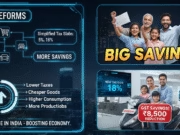The Goods and Services Tax (GST) is a landmark reform. It has unified our nation’s taxes. The recent GST reforms mark another major milestone. They are designed to benefit every Indian household. These changes simplify the tax structure. Furthermore, they reduce the tax burden on citizens. This is a significant shift. It creates a more inclusive economic environment. The aim is to boost our entire economy.
Initially, GST was a big change. Many people found it confusing. Businesses faced new compliance challenges. However, the government has consistently worked to improve it. The new reforms are a direct result. They listen to the feedback from citizens. Now, the system is much more transparent. It is also easier to understand. This is a huge win for everyone.

Putting Money Back In The Pockets of People
The most notable change is the new tax slab structure. The old 12% and 28% slabs have been eliminated. This simplified approach is a game-changer. It makes tax calculations much clearer. The new two-slab system (5% and 18%) directly impacts household budgets. Many everyday essentials now fall under the lowest 5% slab. This includes items like soaps and toothpaste. Other food items like packaged bhujia and pasta are also included. Such changes offer immediate savings. These savings accumulate over time.
For middle-class families, the relief is substantial. Imagine buying a new car or two-wheeler. Previously, these were taxed at a high 28%. Now, the rate is reduced to 18%. This makes vehicles more affordable. It fuels aspiration among the youth. Similarly, household appliances like TVs and ACs are cheaper. This boosts consumer spending. Increased spending drives demand. Demand stimulates manufacturing.
Let us consider a small anecdote. There is a family in Vadodara. The father, a government employee, wanted to buy a new scooter. The high taxes were a big hurdle. After the reforms, he found his dream scooter was now thousands of rupees cheaper. The family celebrated. They felt a tangible sense of relief. This story is not unique. It is happening across India. Such price reductions directly improve the quality of life.

Boosting the Broader Economy
The impact of these reforms goes beyond household savings. It creates a positive cycle. Cheaper goods lead to higher consumption. Higher consumption encourages more production. This production boom creates more jobs. Consequently, the economy gets a significant boost. It is a virtuous cycle of growth.
The reforms also target specific sectors. Lower rates on farm machinery help farmers. It reduces their input costs. This strengthens our agricultural sector. Likewise, handicrafts now have lower tax rates. This supports artisans and cottage industries. It promotes our rich cultural heritage.
Furthermore, the reforms improve business environment. Simplification of compliance eases the burden on MSMEs. Micro, Small, and Medium Enterprises are the backbone of our economy. Faster refunds and streamlined registration are now a reality. This encourages more businesses to enter the formal economy. It widens the tax base. A wider tax base means more government revenue. This revenue can be used for public welfare.

A Look Towards the Future
This bold move positions India for sustained growth. Analysts project a boost in consumption. This could lower inflation in the short term. The simplified structure attracts foreign investment. It makes India an attractive business destination. Our nation is building a reputation for ease of doing business.
The GST reform is a strategic move. It reinforces the ‘Aatmanirbhar Bharat’ vision. This vision promotes self-reliance. By lowering taxes on domestic goods, it supports local manufacturers. It reduces our reliance on imports. This strengthens our global supply chain position. It is a testament to India’s fiscal maturity.

Frequently Asked Questions (FAQ)
Q1: What are the main changes in the new GST reforms?
The primary change is the new tax structure. The 12% and 28% slabs are gone. A simplified two-slab system of 5% and 18% is in place.
Q2: How does this affect my daily shopping?
Many essential goods like soaps, toothpaste, and packaged foods are now taxed at 5%. This will lower your monthly household expenses.
Q3: Will the prices of big-ticket items also go down?
Yes. Items like small cars, two-wheelers, and consumer durables now have a lower tax rate. This makes them significantly more affordable for everyone.
Q4: How do these reforms help small businesses?
The reforms simplify compliance procedures. They make registration and refunds faster. This reduces the burden on small businesses and encourages them to grow.
Q5: What is the long-term impact on the Indian economy?
The reforms are expected to boost consumer spending. This will drive economic growth and create jobs. It also formalizes the economy and increases government revenue.
We have explored the incredible impact of these reforms. They are a true game-changer. Tell us your thoughts. How have these changes affected your life?
#GSTIndia #GSTReforms #IndianEconomy #Taxation #AatmanirbharBharat #MakeInIndia #Finance #IndianMiddleClass #TaxSlabs #Economy





































